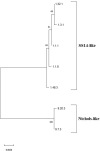High frequency of Nichols-like strains and increased levels of macrolide resistance in Treponema pallidum in clinical samples from Buenos Aires, Argentina
- PMID: 36175452
- PMCID: PMC9522787
- DOI: 10.1038/s41598-022-20410-5
High frequency of Nichols-like strains and increased levels of macrolide resistance in Treponema pallidum in clinical samples from Buenos Aires, Argentina
Abstract
Globally, 94% of Treponema pallidum subsp. pallidum (TPA) clinical strains belong to the SS14-like group and 6% to the Nichols-like group, with a prevalence of macrolide resistance of 90%. Our goal was to determine whether local TPA strain distribution and macrolide resistance frequency have changed significantly since our last report, which revealed that Buenos Aires had a high frequency of Nichols-like strains (27%) and low levels of macrolide resistance (14%). Swab samples from patients with suspected syphilis were collected during 2015-2019 and loci TP0136, TP0548, TP0705 were sequenced in order to perform multilocus sequence typing. Strains were classified as Nichols-like or SS14-like. The presence of macrolide resistance-associated mutations was determined by examination of the 23S rDNA gene sequence. Of 46 typeable samples, 37% were classified as Nichols-like and 63% as SS14-like. Macrolide resistance prevalence was 45.7%. Seven allelic profiles were found, five were SS14-like and two were Nichols-like. The frequency of Nichols-like strains increased between studies (26.8% vs. 37%, p = 0.36). A dramatic increase was found in the frequency of macrolide resistant strains between studies (14.3% vs. 45.7%, p = 0.005). Our results are in agreement with international trends and underscore the need to pursue further TPA molecular typing studies in South America.
© 2022. The Author(s).
Conflict of interest statement
The authors declare no competing interests.
Figures


References
-
- World Health Organization. Global progress report on HIV, viral hepatitis and sexually transmitted infections, 2021: Accountability for the global health sector strategies 2016–2021: Actions for impact: Web annex 2: Data methods. https://apps.who.int/iris/bitstream/handle/10665/342813/9789240030992-en... (2021).
-
- Dirección de Sida y ETS & Ministerio de Salud de la Nación. Boletín N° 38: Respuesta al VIH y las ITS en la Argentina. https://bancos.salud.gob.ar/recurso/boletin-ndeg-38-respuesta-al-vih-y-l... (2021).
-
- Pando MA, et al. Prevalence of HIV and other sexually transmitted infections among female commercial sex workers in Argentina. Am. J. Trop. Med. Hyg. 2006;74:233–238. - PubMed
Publication types
MeSH terms
Substances
Supplementary concepts
LinkOut - more resources
Full Text Sources

